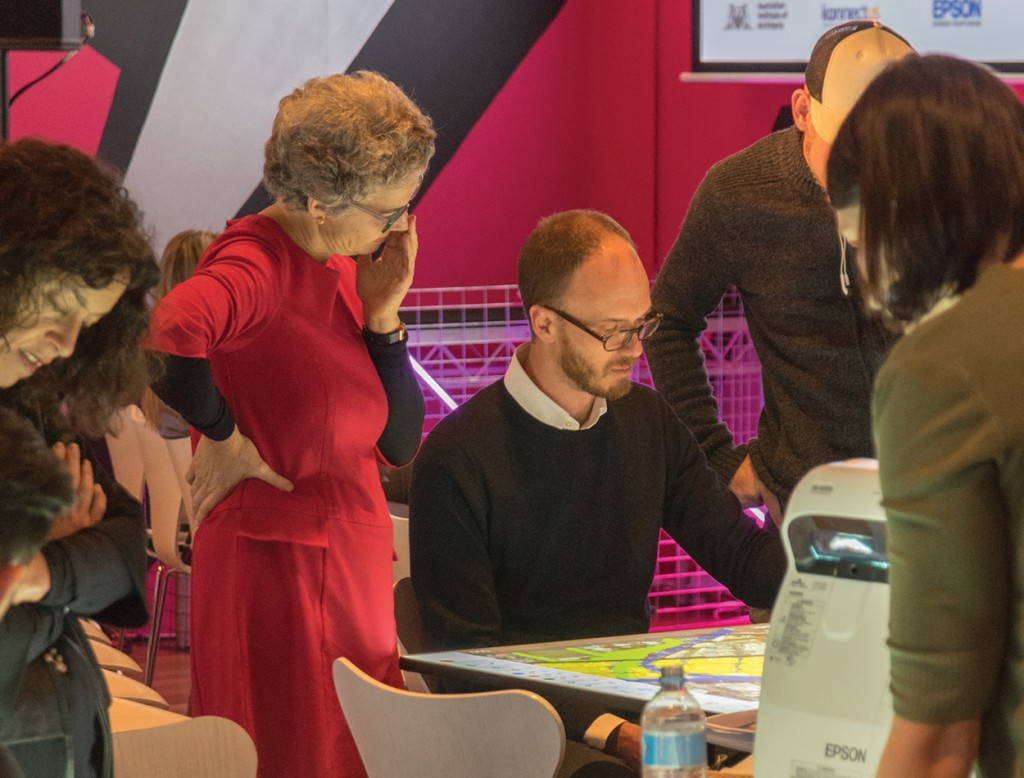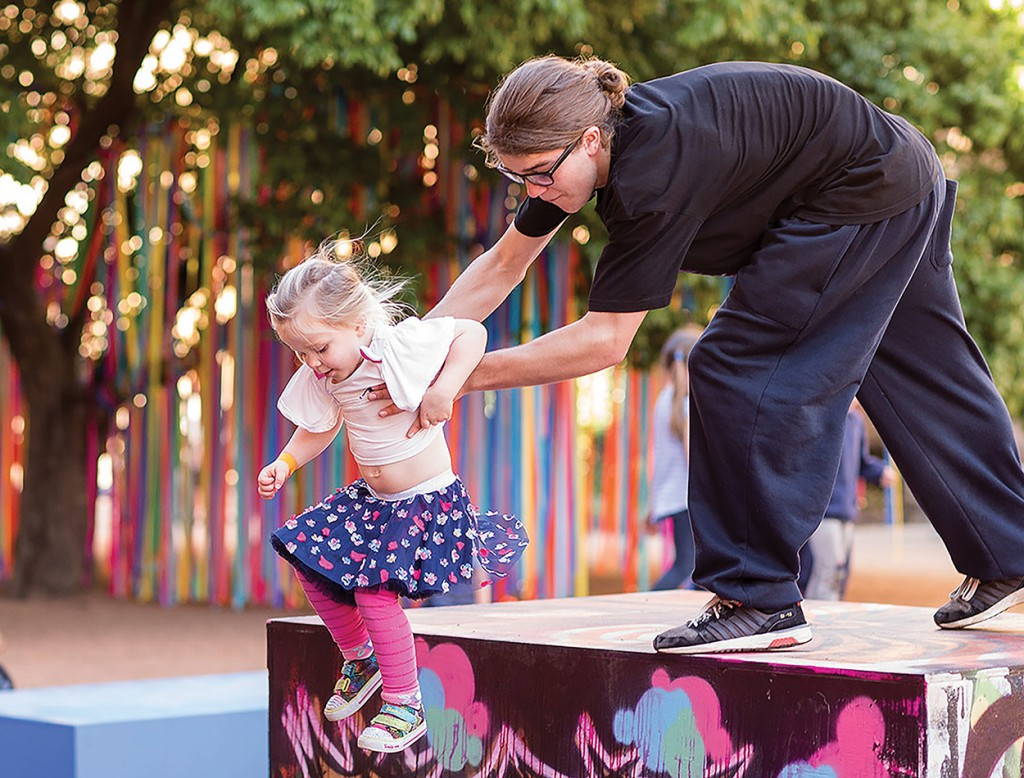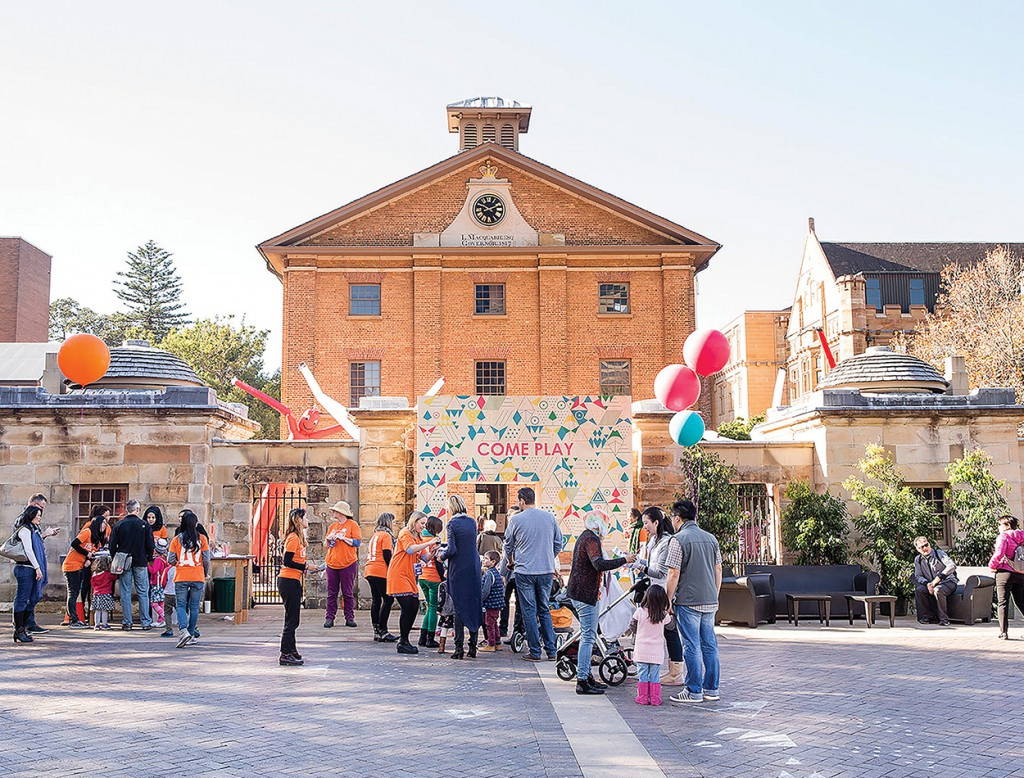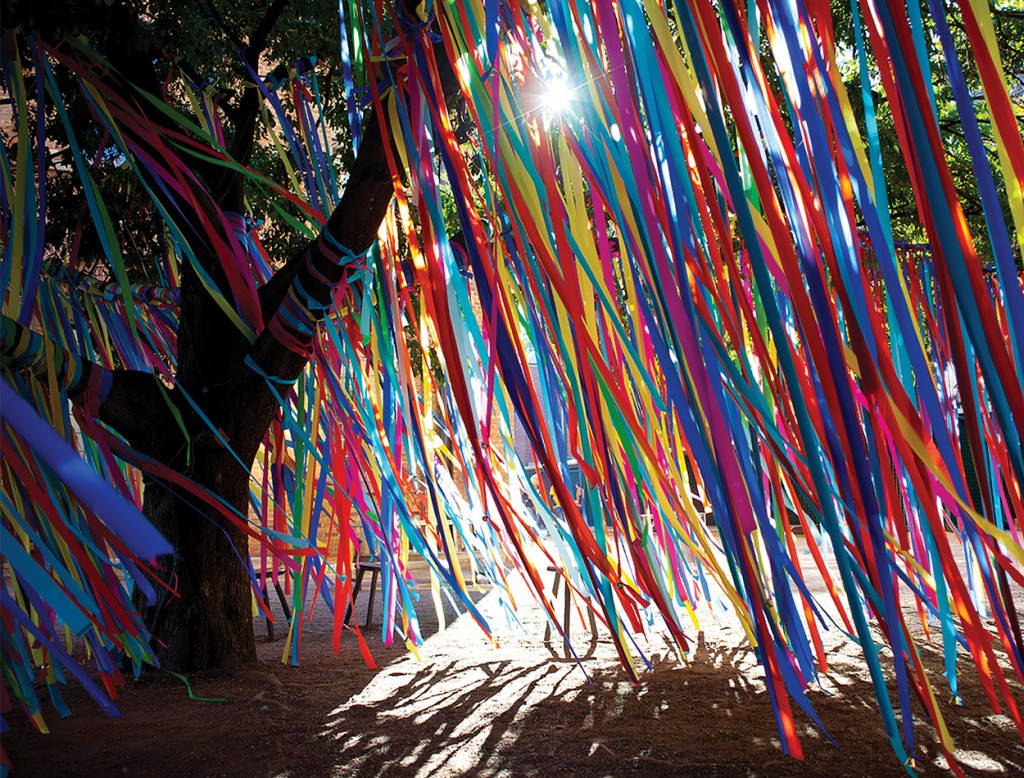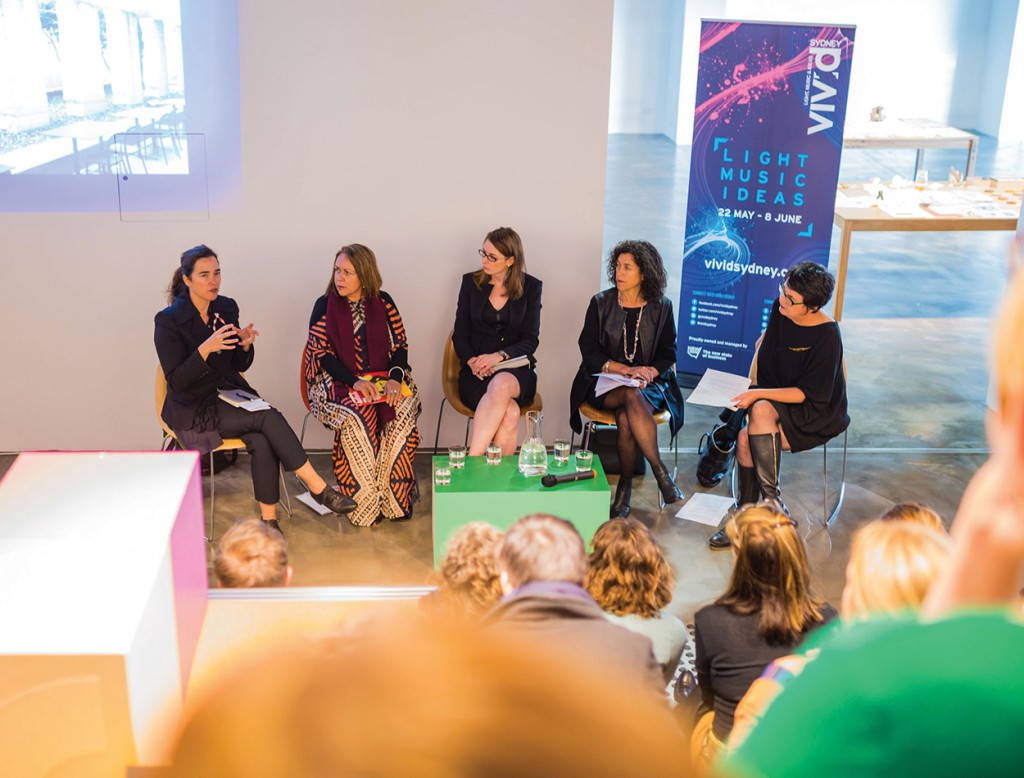



table of contents

previous articles

next articles
Feature article



CONTENTS
- Speculate - Super High Density, Vivid Ideas Exchange 2015. Photo: Stephen Pierce
Vivid 2015 in Review
This year the Vivid program incorporated a number of events relating to architecture and urban design. Sophie Solomon and Nicola Balch report on three highlights from the festival.
Speculate – Super High Density
This year at Vivid 2015, Sydney saw its very first live urban design performance; a facilitated hypothetical workshop that explored the processes behind master planning a major city project. The brief tasked a team of nine urban heavyweights to amplify their respective roles of developer, urban designer, academic, heritage advisor, environmentalist, landscape architect and architect to produce an engaging approach to urban design which played off the theatrics of the field and highlighted the role of negotiating between disciplines. The aim of this was to explore the challenges of super high density and demystify the process of design to show how many competing interests can come together.
The selected site occupied the industrial area north of Clyde station stretched across 240,000sqm of development lots and was bisected by Parramatta Road. This translates into 480,000sqm gross floor area and approximately 4,500 apartments when adopting the business as usual approach. In less than two hours the team had to formulate a design proposal which was modeled live, including on the spot feasibility testing, assessing the viability of the evolving outcomes along the way. To achieve this effectively the event was spread, theatre-in-the-round style around a central ALS (Active Learning Space) composed of three hubs. Each hub was equipped with a computer and interactive projector that displayed the participants sketches in action on overhead screens for the audience. The set up made these proposals work almost as three distinctive and competing teams, adding to the theatrics of the event and enhancing the debate. Each of the schemes was then pulled together and summarised by the event’s provocateur, Roderick Simpson, who moved around the participants consolidating their responses, both for the understanding of the audience and to direct the outcomes of these live negotiations for the modelling team and distillers.
The overarching intent of the event was for the participants to develop an urban transition zone, which moved away from the business as usual approach to urban design. The basis of this was twofold, firstly because a business as usual approach was not viable for the site, based on density requirements versus provision of required open space, but also due to its tendency to produce bland and characterless places. This meant that participants could break, invent and throw out rules so long as it worked toward the production of a high quality urban environment. In full the participants were given a live testing ground where what could be was given precedence over what should be, allowing them room to speculate, rebut and develop different design methods hypothesising what they could offer the city. The event was essentially an opportunity to think differently and demonstrate the value of this by moving away from standardised responses to speculate integrated design strategies and what they can offer our urban environment. In this area each outcome is rigorously considered and undergoes ongoing development as they are measured and tested by peers, software and the audience.
The value in the event was not to reach a final outcome for the site but to demonstrate how transparent negotiation between varied approaches, disciplines, priorities and attitudes can elucidate the design process and offer innovative responses to shaping our environment. Provocateur Roderick Simpson summed it all up by stating, “There are some real inefficiencies in doing things the normal way”.
The afternoon was a charrette on steroids where fast pace and grand ambition was navigated by 15 participants, panellists and modellers including: Deborah Dearing, Marcus Trimble, Tim Williams, Andrew Nimmo, Jon King, Tamara Dannellan, Barbara Schaffer, John Carfi, Kurt Iveson, Kati Westlake, Leanne Niblock, Joseph Loh, Chris Kelly and Daniel Kim. This intensity of aim coupled with the diversity of competing interests meant the event reached an admirable balance between serious intent and playful execution. I do not think I have ever sat through a faster two hours in my life.
Nicola Balch
Urban Designer, McGregor Coxall
ArchiKidz: Seen & Heard in the City
How much agency do our children, younger siblings, nieces and nephews have in our built environment? The truth is very little. Cities particularly since the industrial revolution have historically been at odds with our children. The humanitarian ambition of the playground which aimed to remove children from our streets in the late 1800s aided by vehicular dominance, stranger danger, technology and activity schedules has led to what is often called “the end of the free range kid”. We inhabit an era in which children have little to no engagement with the urban environment, and whose roaming territory is approximately 1/9 of their parents. Children across the world occupy cities run by and created for adults. We have established an environment so hostile for children that our solution is to continually keep increasing the number of segregated spaces we designate to them. We live in urban environments that often strive to isolate their participation and neglect their citizenship. Thankfully, due to a movement which began in the mid to late nineties this may be starting to change.
In June, Archikidz in partnership with Sydney Living Museums for Vivid 2015 launched a new breed of playground at the Hyde Park Barracks in Sydney’s CBD. This temporary play space hybridised consultation with free-play and turned its focus outward to the city. The concept of PLAY[ground] was developed off the back of the United Nations framework and vision for child friendly cities and undertook a range of activities with the purpose of engaging children in the diplomacy of the city. These exercises offered different engagement methods which sought to develop spatial thinking and offer a platform for children to have their say. This strategic concept for city making gives children the right to: influence decision making; express their opinion; participate in family, community and social life; and be seen as an equal citizen so their needs can be actively taken into account.
This mantra was adopted in three key themes throughout the install, where empowerment was considered though design, physical engagement and discussion. Tucked within the walls of the barracks, kids interacted with a set of Alisa Andrasek and Jose Sanchez’s urban toy Bloom, explored design technology though 3D printing sessions, and built green walls with Junglefy. Breaking out across the street into Queens Square, Parkour lessons by Sydney based Jump Squad HQ encouraged children of all age groups to rethink their physical engagement with the everyday obstacles of urban spaces. And weaved in amongst these were the roaming Seen and Heard crew, a team of volunteers and media specialists armed with clipboards, video cameras, microphones and the soul aim of collecting and cataloging children’s thoughts, dreams and perceptions of the city. At centerpiece of this consolatory process sat a ply mock up of a traditional gable roof home entitled Little House: Big Ideas. Greeting you on entry, this pilot project with HASSELL is a pitched “reverse information cubby house” offering a space for kids to groupthink how we can build better cities in the future though drawings, discussion and flash card activities. The intent of these diverse strategies is underpinned by an Archikidz belief that children should be both seen and heard in the city and through engagement can help strategise their future.
Archikidz is a global program, yet this devotion to the topic of citizenship is more specific to the Sydney chapter. When I sat down with Director Vanessa Trowell she made it clear a key critical factor of the event was that the findings and data collated from the event would hopefully be able to pave some sort of insight into how children understand and see cities and give direction for tangible future projects. Archikidz fits within a broader global urban movement which aims to integrate children with the future planning and development of our built environment.
It is somewhat ironic that a playground has been used as a platform to begin to ask questions about the future potential of cities for children given that its very invention during the industrial revolution was an act to directly remove them from it. Archikidz has subverted this traditional role from one which simply removes children from the city to one which uses this safe space to explore a variety of modes through which children can be strategically involved in planning for changes in the built environment. All up, the long weekend saw over 6,000 participants and collected 40 interviews, 20 video sessions and 200 big idea worksheets. Given the holistic depth and breath of the installation in approaching its aim, it can be safe to say that the future of Archikidz looks to be an exciting one.
Nicola Balch
Urban Designer, McGregor Coxall
Making Demands: how do we adjust our cities to work for us?
Presented as part of the Sydney Vivid Festival of ideas, the Making Demands seminar and workshop saw a moderated panel discuss how we can make our cities work better for us. The event was hosted by the Gold Club, a guild of pivotal women in Australian design, in conjunction with Parlour, representing women and equity in architecture and landscape architecture. The four panellists were Dr Fiona Foley, indigenous artist and activist; Shelley Penn, architect and strategic advisor; Clare Sowden, development director at PricewaterhouseCoopers and Barbara Schaffer, principal landscape architect for the Government Architect’s Office.
The aim of the event was to awaken the expectations of multi-disciplinary design, and motivate pragmatic and inspired responses within our city. The panel explored these concerns across the realms of public art, urban renewal, architectural leadership and cultural value. The different perspectives of each panellist highlighted the diverse role that women are playing in the design professions and the unique set of skills they bring to each project. Making Demands was fittingly held in the new OBJECT: Australian Design Centre on William Street, in its recent reincarnation from the Object Gallery in Surry Hills. Currently situated in a shop front to the street and small plaza, OBJECT is positioned amongst office buildings, car showrooms, art galleries, gourmet chocolate shops and furniture retailers. It is a constantly changing retail landscape, yet one that seems like it is finally contributing to the public life of the street. Due mostly to the City of Sydney’s Creative Cities Policy this diversity of creative retailers and galleries now occupying the street is enlivening the precinct and encouraging change. This type of urban renewal on the fringes of the city represents strategic design on the micro level, with good policy driving change by enabling diversity and equality into the periphery, therefore allowing for better connections and growth to occur. Formerly an inhospitable, car-choked thoroughfare with little pedestrian appeal, William Street is slowly transforming into the pedestrian boulevard that was envisioned nearly 20 years ago as the Cross City Tunnel was being planned.
This innovative repairing of the city at the grass roots level is also reflected in the interior design of the new OBJECT. Cleverly designed by Those Architects, the space encompasses a gallery and informal presentation/seminar space, with an open connection to the street. The seating area or bund seamlessly connects the two separate gallery spaces that are located at different levels as they correspond to the slope of the street. Sitting across the bund, the seminar participants became actively engaged in the conversation between the moderator and the panelists.
The common theme of the discussion was the role of communication and the understanding it brings for change to occur. Drawing on her years of experience across different scales of architecture in both private and public practice, Shelley Penn made a case for how important and influential architects can be by the understanding and adapting language for specific situations. Penn stated, “Different voices are needed for different contexts and different relationships”. This idea acknowledges the importance of community consultation in strategic design for city making – consultation that can only be achieved by adopting methods of communication that effectively engage the public.
Sophie Solomon
Principal, ssd studio











